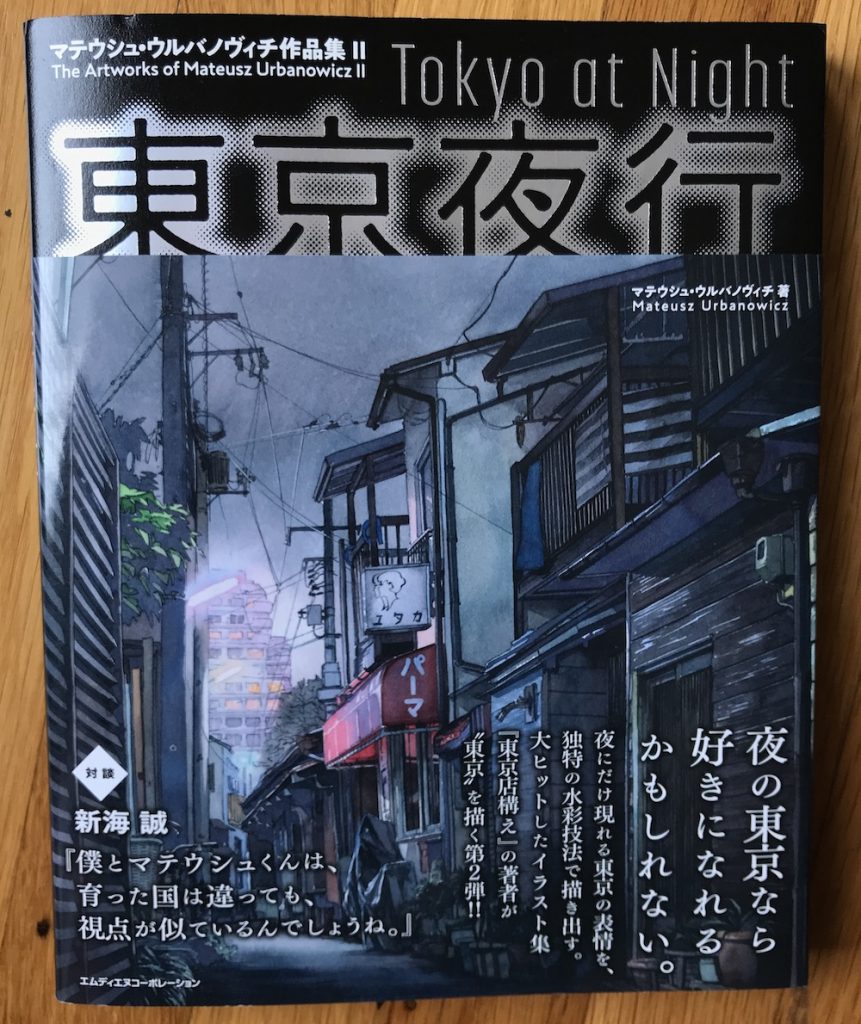
Tokyo at Night (translated Japanese title: Tokyo Night Train Works)
by Mateusz Urbanowicz
published by MdN Corp, Tokyo, Japan
2019
This is a beautiful book of NIGHT TIME contemporary, urban watercolors by a professional artist/illustrator for Japanese animation films. If you have ever wondered what animation artists do in their spare time, the answer is: they create MORE ART!
You may find this book review inevitable, between my fuss over ordering books from Kinokuniya Books in San Francisco, my background in architecture, and my appreciation of the background illustrations in Japanese anime I caught up on during the pandemic. Kinokuniya featured Urbanowicz’ other work, Tokyo Storefronts, prominently in its windows, and those are great, but night time watercolors are definitely within my special area of interest!

There is a lot to appreciate here.
First, Urbanowicz has some conflicted feelings about contemporary urban surfaces in Tokyo. There are a plenty of hyper-modern concrete facades, overhead wires, metal roll-up doors, overpasses, and other functional urban shapes, all of which are both a great visual challenge for an artist AND a sort of painful visual blight for someone who appreciates historic/traditional Japanese design more generally. I like that Urbanowicz embraces this hypermodern chaos, accepting it for what it offers visually, and sharing some of his feelings about it.
On a related note, Urbanowicz isn’t choosing beloved landmarks that would already have a warm place in your heart: he is choosing ordinary urban scenes that you wouldn’t ordinarily go out of your way to glorify. As so many people favor conventionally pretty, “popular” scenes to benefit from existing affection for a subject, I’m all the more impressed for his originality and effort to make remarkable work about ordinary locations.
As a professional illustrator, Urbanowicz takes a very practical approach to these works. He uses waterproof ink where that benefits the work; he uses opaque white paint when that creates an effect he wants; he uses masking fluid; he uses an airbrush when he wants to soften something. He uses watercolor for its strengths, and uses other tools when they contribute. He also revises compositions when the real life arrangement wouldn’t make a great image. He offers and illustrated guide near the end of the book to share his techniques, so we’ll appreciate the human effort that went into doing all this work by hand. It’s quite refreshing that he is so skilled with many tools, and isn’t unduly strict about single tool purity.
I’m especially impressed that he created all of this work on light paper. That required laying down a LOT of pigment, and he chose his materials and approach carefully, so that his washes remained clear and smooth. (My own washes get very grainy in unfortunate ways when I try to work this this kind of saturation, so I really appreciate his fantastic washes – I appreciate just knowing that this kind of saturation is possible!) Many painters render night scenes in opaque paints, especially oils, so seeing this work done in watercolor expands my idea of what is possible in watercolor.
This is an impressive and enjoyable book of great watercolors for fans of watercolor painting, hard-edged urban details, night scenes, Tokyo, Japanese urban environments, and any of Urbanowicz’ other work.
